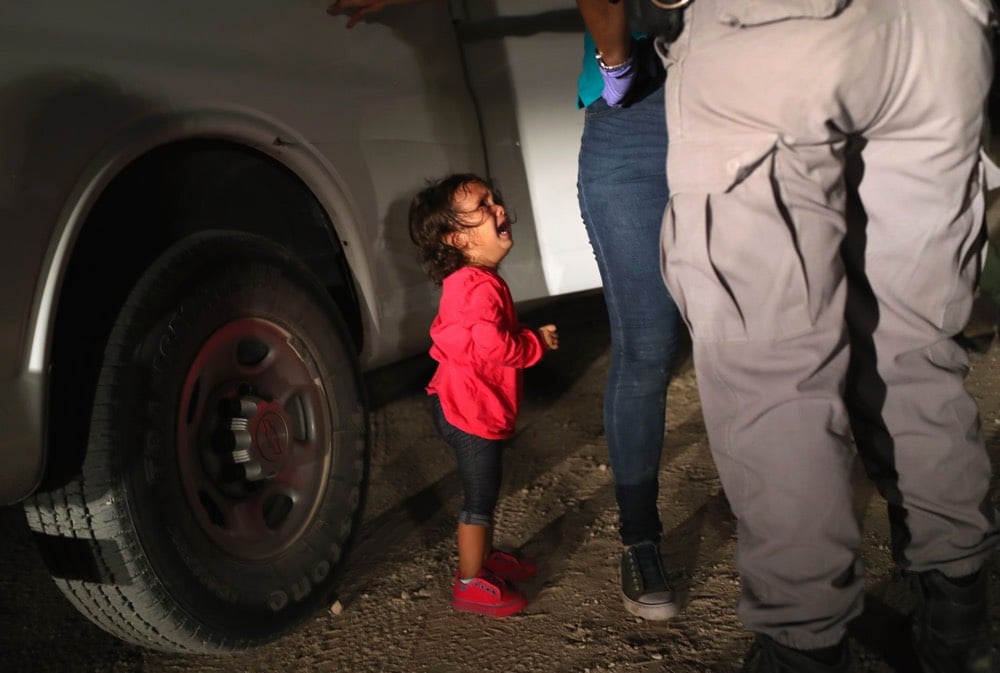The poster child problem

This week’s crisis of children separated from their parents, and both parents and children sent to jails or camps (in most cases) for the misdemeanor of improperly crossing the border, has inspired some excellent critical writing on the power of overpowering imagery, especially the John Moore photograph above.
From Josephine Livingstone, “America’s ‘Poster Child’ Syndrome”:
These poster children present a paradox: They are real, so is their suffering—but they have also been chosen to represent a suffering that is shared by many others… There are several political repercussions of allowing a single child to represent a crisis. The first is that the child herself, literally voiceless in the case of Moore’s photograph, ceases to be an individual. She instead becomes a blank canvas upon which adults project their anxieties and fears. The second is that it obscures the suffering of others—particularly adults. Moore’s photograph captures this young migrant’s isolation so well that it hurts; but, by definition, it leaves out the faces of the rest of her family. It reduces a crisis about human beings of all ages and stages of life to a single image of total vulnerability.
Behind the American response to these images of children lurks an uncomfortable truth: The white majority in this country perceives children of color differently than they perceive adults, in what we might call the visual rhetoric of victimhood. This crisis is happening to babies, toddlers, teenagers, parents, and elderly adults; but the only images that can make America care about its inhumane policy toward immigrants at its borders, the only images that can cause a Republican like Laura Bush to speak on behalf of these foreigners, are photographs of children.
Megan Garber, “How To Look Away”:
In a democracy, if the people are to have a meaningful say over the world and its workings, those people are, fundamentally, obligated to look. And, much more fundamentally, to see. To avert one’s eyes is a privilege that those of us who have the power to act cannot afford to exercise, even when we are complicit in the images. Especially when we are complicit.
It is a dynamic—the democratic alchemy that converts seeing things into changing them—that the president and his surrogates have been objecting to, as they have defended their policy. They have been, this week (with notable absences), busily appearing on cable-news shows and giving disembodied quotes to news outlets, insisting that things aren’t as bad as they seem: that the images and the audio and the evidence are wrong not merely ontologically, but also emotionally. Don’t be duped, they are telling Americans. Your horror is incorrect. The tragedy is false. Your outrage about it, therefore, is false. Because, actually, the truth is so much more complicated than your easy emotions will allow you to believe. Actually, as Fox News host Laura Ingraham insists, the holding pens that seem to house horrors are “essentially summer camps.” And actually, as Fox & Friends’ Steve Doocy instructs, the pens are not cages so much as “walls” that have merely been “built … out of chain-link fences.” And actually, Kirstjen Nielsen wants you to remember, “We provide food, medical, education, all needs that the child requests.” And actually, too, Tom Cotton warns, think of the child-smuggling. And of MS-13. And of sexual assault. And of soccer fields. There are so many reasons to look away, so many other situations more deserving of your outrage and your horror.
And Kainaz Amaria, “Time magazine’s cover isn’t bold or brave. It’s exploitative.”
[When] I saw Time’s cover this morning — and what I can only describe as the misuse of Moore’s original image — my immediate reaction was rage. As a photojournalist, a visuals editor, and an immigrant, I didn’t see it as a powerful statement on President Trump’s attitude toward the family separation crisis or the policies that have ripped more than 2,000 vulnerable children from their parents.
I see it as an insensitive and exploitative play to sell magazines — and one that, albeit unintentionally, offers up this personal tragedy to be memed and ridiculed…
Vox’s Brian Resnick has written about the limits of human compassion and the impact an image can have. In it, he talks to Paul Slovic, a psychologist at the University of Oregon, who says: “Individual stories and individual photographs can be effective for a while. They capture our attention — they get us to see the reality, to glimpse the reality at a scale we can understand and connect to emotionally. But then there has to be somewhere to go with it.”
I haven’t yet read anything comparable diving into the effect of the ProPublica audio of imprisoned children separated from their parents by immigration officials, apart from this behind-the-scenes video on the how the audio was obtained. But I’d certainly be interested in doing so.





Stay Connected